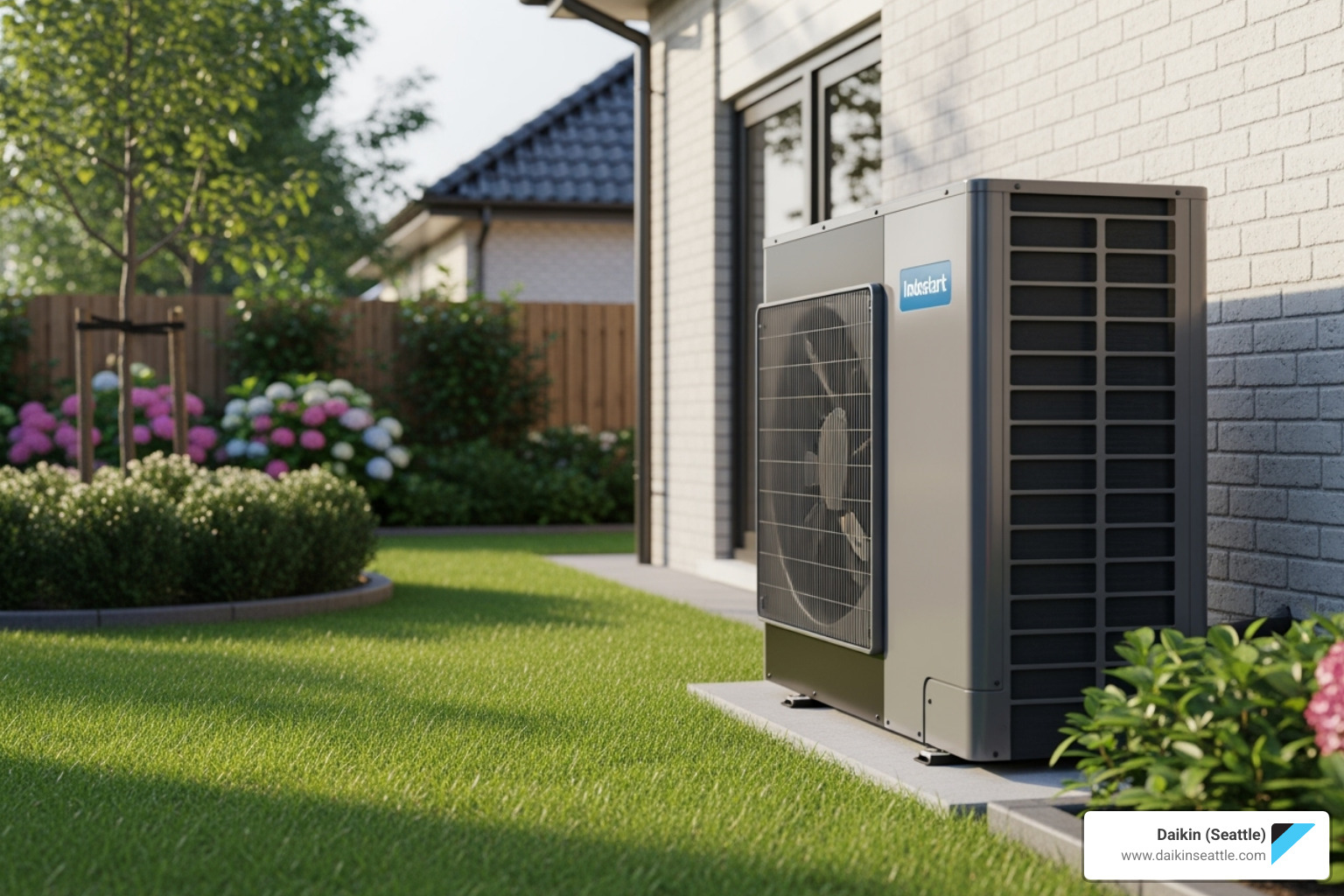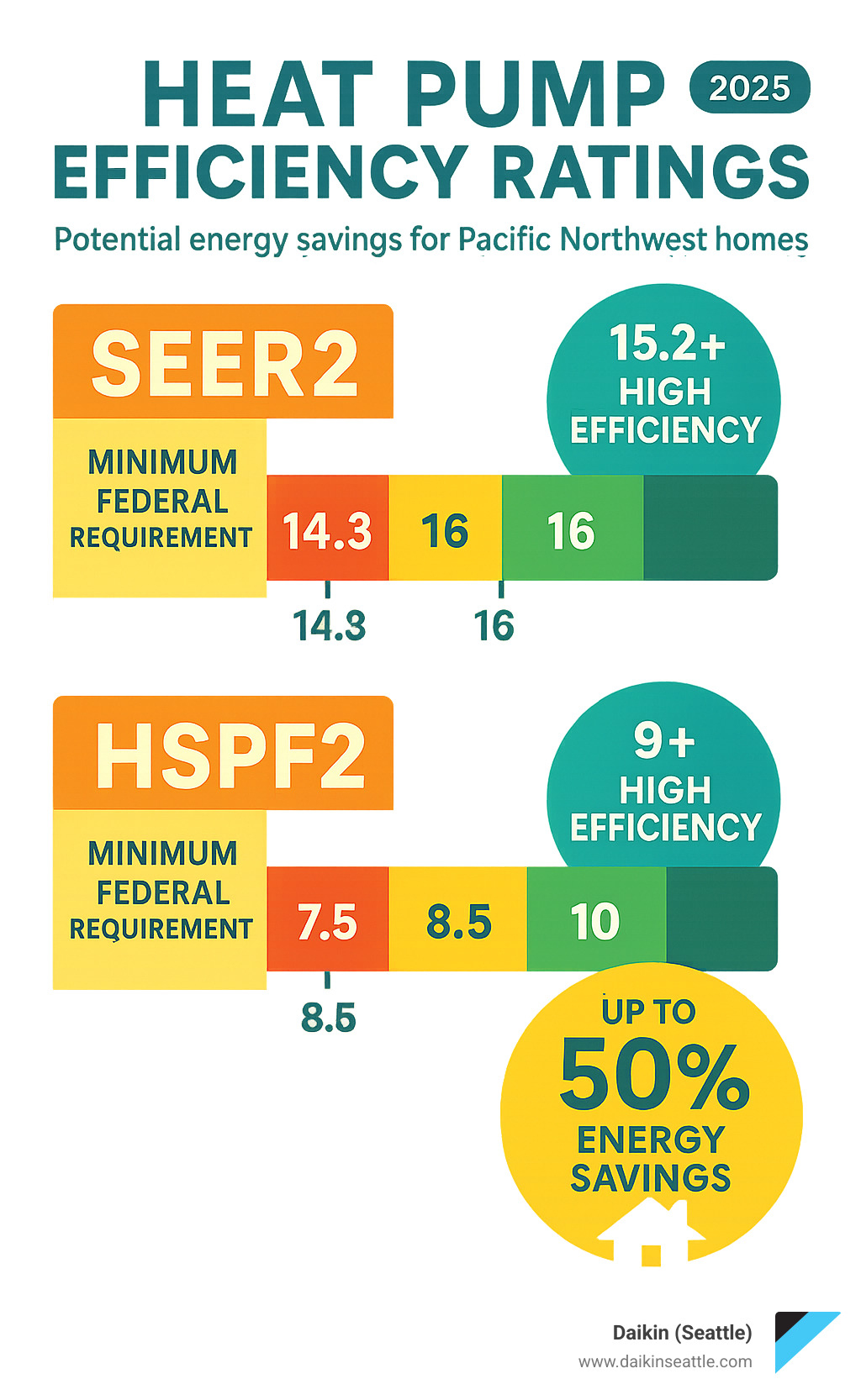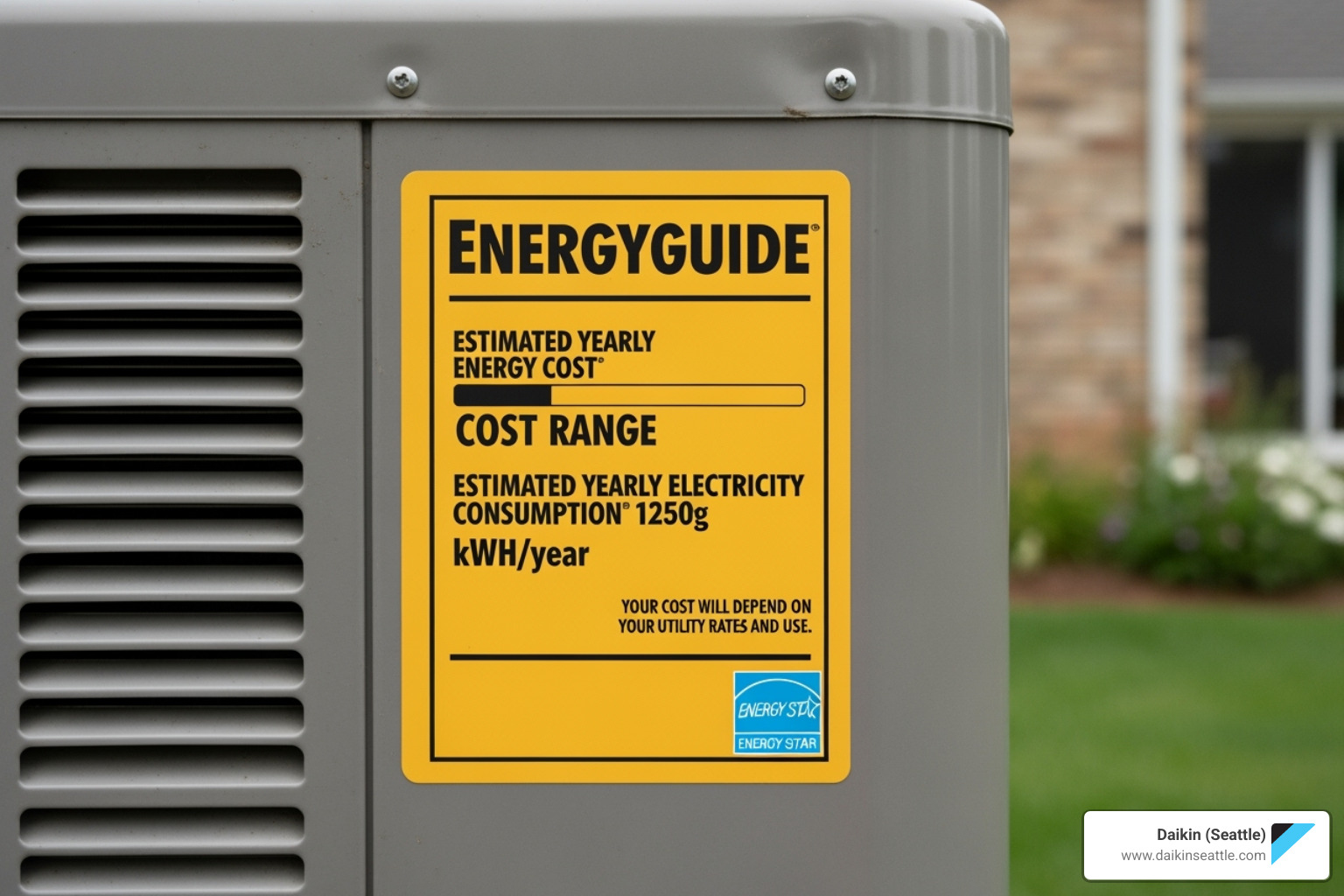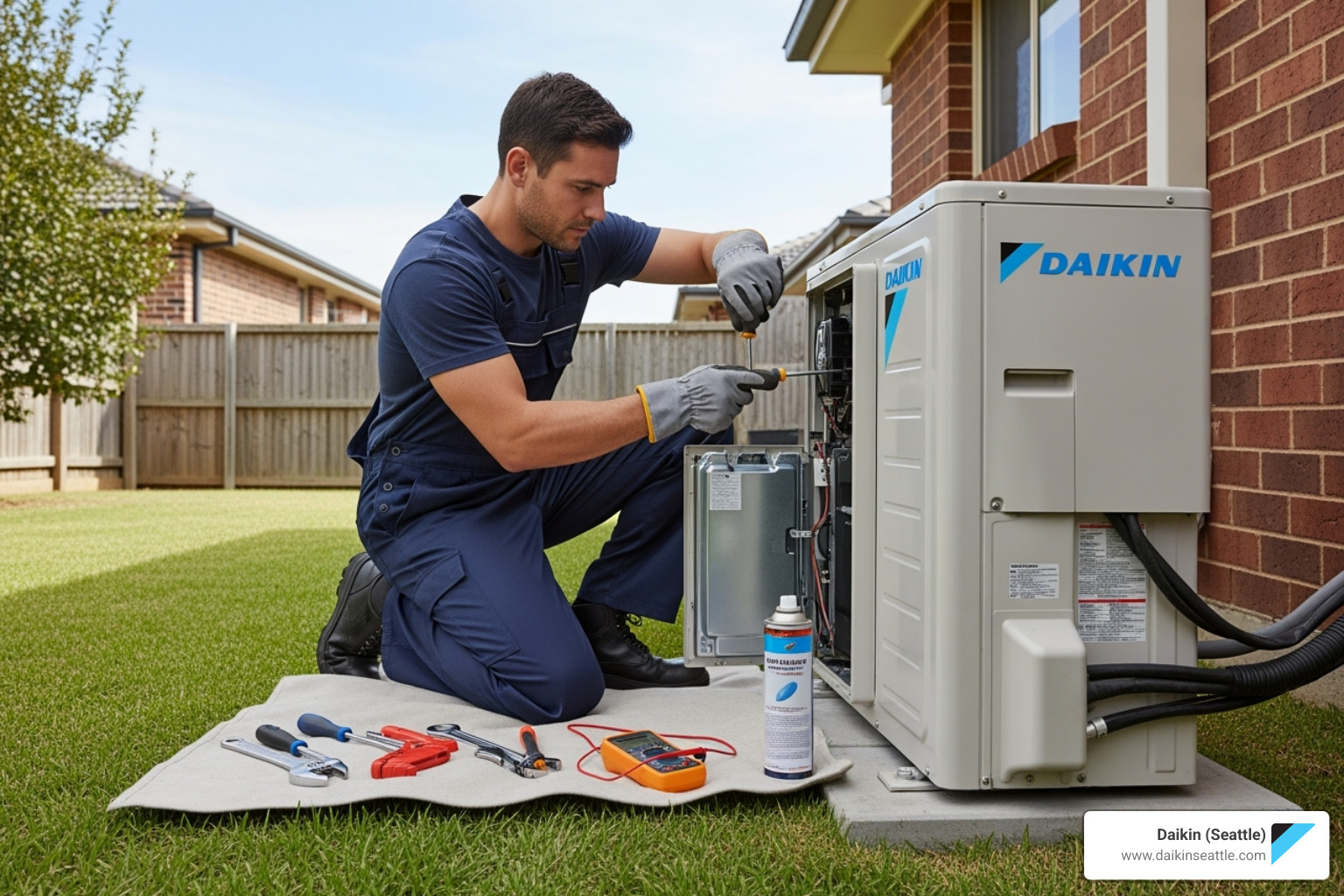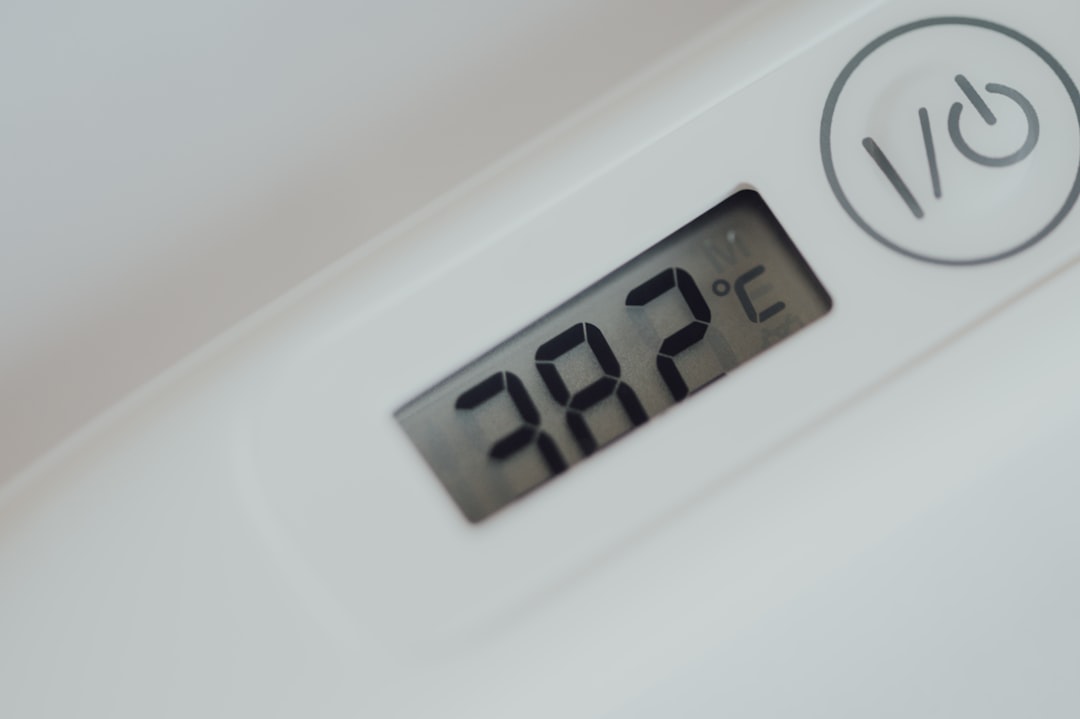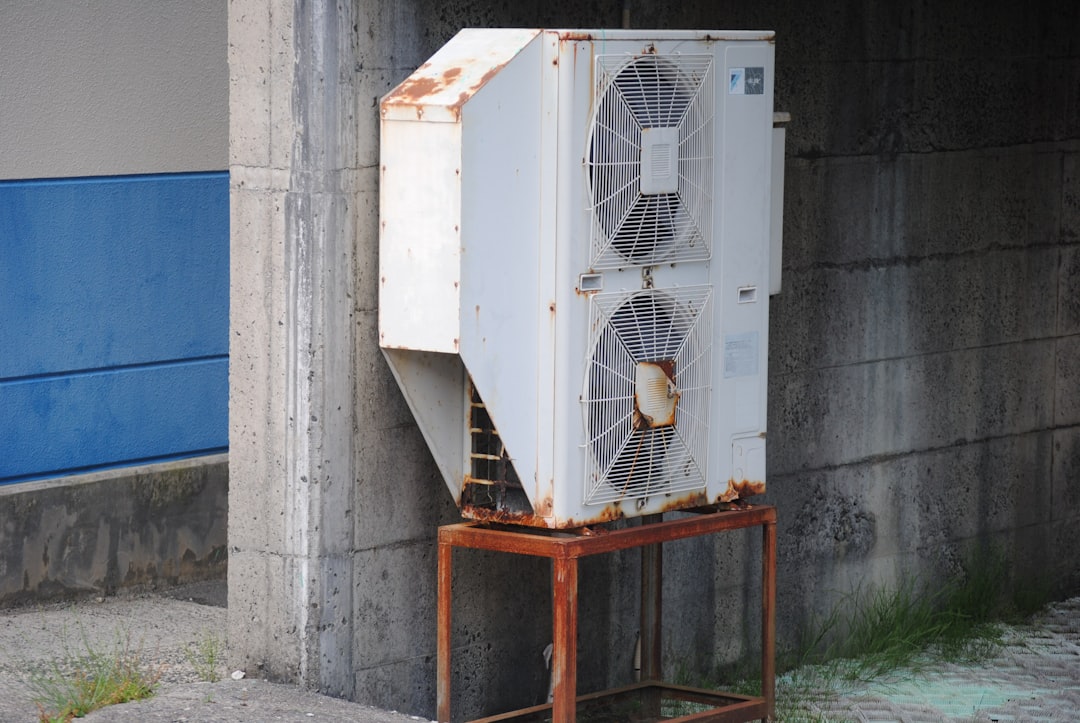Why Heat Pump Efficiency Ratings Matter for Your Home
Heat pump efficiency rating systems help you understand how much heating and cooling you get for every dollar spent on electricity. These ratings directly impact your energy bills, comfort levels, and environmental footprint.
Key Heat Pump Efficiency Ratings:
- SEER2 – Measures cooling efficiency (higher is better, look for 15.2+)
- HSPF2 – Measures heating efficiency (higher is better, look for 7.5+)
- EER2 – Point-in-time cooling efficiency at specific conditions
- COP – Heat output versus energy input ratio (mainly for geothermal)
Heat pumps can move 300% to 500% more energy than they consume by transferring heat rather than generating it. This makes them incredibly efficient compared to traditional heating systems like electric resistance heaters or even high-efficiency gas furnaces. A high-efficiency gas furnace, for example, is around 95% efficient, while a heat pump can transfer three to five times the energy it consumes!
As of January 1, 2023, the Department of Energy requires all split-system heat pumps to meet minimum standards of 14.3 SEER2 for cooling and 7.5 HSPF2 for heating. However, high-efficiency models rated at 17 SEER2 and above for cooling, or 9 HSPF2 and above for heating, can deliver significant energy savings.
Upgrading from an older unit with a SEER rating of 8 to a SEER2 rating of 15.3 could save you roughly 50% on your energy bill. For Seattle homeowners dealing with both heating and cooling seasons, understanding these ratings helps you choose a system that keeps you comfortable year-round while minimizing utility costs.
Decoding the Primary Heat Pump Efficiency Ratings
Think of heat pump efficiency ratings like a nutrition label on food – they tell you exactly what you’re getting for your energy dollar. But unlike a simple calorie count, heat pump efficiency comes with several different numbers, each revealing something important about how your system performs.
The main players in the efficiency game are SEER2 and HSPF2 – these seasonal ratings give you the big picture of how your heat pump performs year-round. But there are also supporting characters like EER2 and COP that matter in specific situations, especially with geothermal systems.
The U.S. Department of Energy explains heat pump systems and sets the standards we follow. They define HSPF2 as the total heating your home needs during heating season divided by all the electricity your heat pump uses to provide it. SEER2 works the same way but for cooling – it’s all the heat removed from your home during cooling season divided by the electricity consumed.
SEER2 vs. HSPF2: Cooling and Heating Efficiency
Your heat pump is like a talented friend who’s great at two completely different things. Maybe they’re amazing at both cooking and fixing cars – each skill deserves its own rating!
SEER2 (Seasonal Energy Efficiency Ratio 2) measures how well your heat pump cools your home throughout the entire cooling season. Think of it as your system’s summer report card. A higher SEER2 number means your heat pump removes more heat from your house while using less electricity – perfect for those surprisingly warm Pacific Northwest summers. Understanding power efficiency in cooling systems becomes especially important when you’re trying to stay comfortable without breaking the bank.
HSPF2 (Heating Seasonal Performance Factor 2) does the same thing but for heating. This rating shows how efficiently your heat pump keeps you warm during the entire heating season. Since we spend a good chunk of the year heating our homes here in Seattle, a strong HSPF2 rating can make a real difference in your energy bills.
| Rating | What it Measures | Season it Applies To | What a Higher Number Means |
|---|---|---|---|
| SEER2 | Cooling efficiency | Cooling season (spring/summer) | More efficient cooling, lower electricity use for AC |
| HSPF2 | Heating efficiency | Heating season (fall/winter) | More efficient heating, lower electricity use for warmth |
The Shift from SEER/HSPF to SEER2/HSPF2
You might wonder why we suddenly have these “2” versions of efficiency ratings. It’s not just a marketing gimmick – there’s actually a good reason behind it!
Starting January 1, 2023, the Department of Energy rolled out new DOE testing procedures that better reflect how heat pumps actually work in real homes. The updated 2023 standards use what’s called M1 testing, which accounts for things like static pressure in your ductwork.
The old testing methods were a bit like judging a car’s gas mileage on a perfectly flat road with no wind. The new SEER2 and HSPF2 ratings test systems under real-world conditions – with the resistance and pressure that actual ductwork creates.
This means the numbers might look slightly lower than the old SEER and HSPF ratings for the same unit, but don’t worry – your heat pump didn’t get less efficient overnight. The testing just got more honest about what you can expect in your actual home.
Understanding EER2 and COP
While SEER2 and HSPF2 give you the seasonal big picture, EER2 and COP are like snapshots – they show you exactly how your system performs under specific conditions.
Energy Efficiency Ratio 2 (EER2) measures cooling efficiency at a single moment in time, typically when it’s 95°F outside and 80°F inside with 50% humidity. Think of EER2 as your heat pump’s performance during the absolute hottest day of the year. While SEER2 tells you about the whole cooling season, EER2 shows you what happens when your system is working its hardest.
Coefficient of Performance (COP) is beautifully simple – it tells you how many units of heat you get for every unit of electricity you put in. A COP of 3 means your heat pump delivers three times more energy than it consumes. That’s pretty impressive when you think about it!
COP becomes especially important with geothermal systems, where the stable ground temperature allows for consistently high performance. These point-in-time ratings help you understand peak performance, while secondary metrics like EER2 and COP round out the efficiency picture beyond the main seasonal ratings.
For most homeowners choosing air-source heat pumps, SEER2 and HSPF2 are your main guides. But understanding these additional ratings helps you get the complete efficiency story.
What is a Good Heat Pump Efficiency Rating?
Defining what constitutes a “good” heat pump efficiency rating isn’t just about hitting a certain number; it’s about finding the sweet spot between initial investment, long-term energy savings, and your specific climate needs. While federal minimums provide a baseline, choosing a unit with a higher efficiency rating can lead to significant long-term savings and a more comfortable home.
When we look for the most energy efficient HVAC systems, we’re aiming for that optimal balance. Heat pumps with higher efficiency ratings generally have a higher upfront cost, but their ability to drastically reduce your monthly energy bills often means they pay for themselves over time. This makes them a smart investment for homeowners looking to maximize their comfort and minimize their environmental footprint.
Minimum vs. High-Efficiency Standards
As of January 1, 2023, the Department of Energy has set new minimum allowable efficiency standards for residential, air-source, split-system heat pumps. For cooling, the minimum is 14.3 SEER2. For heating, the minimum is 7.5 HSPF2. These are the lowest acceptable ratings for new units sold today.
However, a “good” or “high-efficiency” rating goes well beyond these minimums. We consider models rated at 17 SEER2 and above to be highly efficient for cooling. For heating, anything above 9 HSPF2 should be considered a high-efficiency model, with some reaching as high as 10.5 HSPF2. High-efficiency air-source heat pumps can even be rated up to 22 SEER2.
For homeowners truly aiming for top-tier performance and maximum savings, we always recommend looking for the ENERGY STAR label. ENERGY STAR certified products meet strict energy performance standards set by the U.S. EPA. Even better, look for products that have earned the “ENERGY STAR Most Efficient” designation. These represent the year’s best for energy savings and environmental protection, delivering cutting-edge energy efficiency and technological innovation.
Here are some examples of what to look for:
- For the ENERGY STAR label: A heat pump must have an HSPF rating of at least 8.2 and a SEER rating of 12 or greater (note: these are older SEER/HSPF standards, but still indicate high performance).
- For high efficiency: Aim for 17+ SEER2 and 9+ HSPF2.
You can find a complete list of ENERGY STAR certified heat pumps, including those designated “Most Efficient,” on the ENERGY STAR website.
Regional Requirements and Cold-Climate Performance
The importance of a high heat pump efficiency rating can vary significantly depending on where you live. While nationwide minimums apply, some regions might have additional requirements, and your specific climate dictates which rating (SEER2 or HSPF2) you should prioritize.
For instance, the U.S. is divided into different climate zones with varying heating and cooling demands. In the Pacific Northwest, including Seattle and Tukwila, we experience both distinct heating and cooling seasons, making both a high HSPF2 and a respectable SEER2 crucial for year-round comfort and energy savings.
One of the most exciting advancements in heat pump technology is the development of cold-climate heat pumps. Older heat pump models traditionally saw a drop in efficiency as outdoor temperatures fell below 25-30°F, often relying on supplemental electric resistance heating. However, newer cold-climate heat pumps are engineered to perform exceptionally well in much lower temperatures. Many of these units can operate efficiently down to 5°F or even -22°F (-30°C), while still providing energy-efficient heating.
This means that for residents of the Pacific Northwest, a high-efficiency cold-climate heat pump is a legitimate and powerful heating alternative, even during our chillier winter months. They can significantly reduce reliance on less efficient backup heating systems, leading to substantial energy savings. Our team at Daikin Seattle offers custom heat pump solutions for Seattle homes, designed to thrive in our local climate.
Key Factors That Influence Real-World Efficiency
While the heat pump efficiency rating on the label gives us a great starting point, the actual performance you experience in your home can be influenced by several other critical factors. It’s like buying a high-performance car; its real-world fuel economy depends on how you drive it, how well it’s maintained, and even the type of roads you’re on.
Why Proper Sizing and Installation are Crucial
This is arguably one of the most important factors. A heat pump, no matter how high its SEER2 or HSPF2 rating, will not perform optimally if it’s not sized correctly for your home or if it’s installed improperly.
- Oversized units: If a heat pump is too large for your home, it will cycle on and off too frequently (this is called “short cycling”). This wastes energy, puts unnecessary wear and tear on the system components, and can lead to inconsistent temperatures and poor dehumidification. It’s like using a fire hose to water a small plant – overkill and inefficient.
- Undersized units: Conversely, a heat pump that’s too small will struggle to heat or cool your home adequately, especially during peak demand. It will run almost constantly, consuming more energy without providing the desired comfort, and potentially shortening its lifespan.
That’s why a professional load calculation, performed by a certified HVAC technician, is absolutely crucial. They consider factors like your home’s square footage, insulation levels, window types, and local climate to determine the precise heating and cooling capacity your home needs. Proper installation ensures that all components work together seamlessly, from the refrigerant lines to the ductwork, maximizing the unit’s rated efficiency.
How Climate Impacts Your Heat Pump Efficiency Rating
We’ve touched on this, but it bears repeating: your local climate significantly affects how your heat pump performs.
- Temperature fluctuations: While modern cold-climate heat pumps handle low temperatures remarkably well, extreme cold still means the unit has to work harder to extract heat. In very cold climates, a hybrid heat system (combining a heat pump with a traditional furnace) might be a preferred option for optimal comfort and efficiency, allowing the heat pump to handle moderate cold and the furnace to kick in during severe drops.
- Humidity levels: In humid climates, a heat pump’s ability to dehumidify can greatly impact comfort. High-efficiency heat pumps generally dehumidify better than standard models by running more continuously at lower capacities.
- Backup heating systems: In areas with very low winter temperatures, a heat pump might require a supplemental heating source (like electric resistance coils or a furnace) to maintain comfort. The efficiency of this backup system also plays a role in your overall energy consumption.
For residents in Bellevue and throughout the Pacific Northwest, understanding how our specific climate impacts your system’s performance is key to selecting the right solution. Our heat pump solutions in Bellevue are custom to these regional considerations.
The Role of Advanced Features like Inverter Technology
Technological advancements play a huge role in boosting a heat pump’s real-world efficiency. One of the most impactful is inverter technology.
Traditional heat pumps often have single-speed compressors, meaning they are either fully “on” or fully “off.” This can lead to temperature swings and less efficient operation. Inverter technology, on the other hand, uses variable-speed compressors. This allows the heat pump to precisely adjust its output to match your home’s heating or cooling needs.
Think of it like driving a car: a single-speed car is either accelerating or braking, while a variable-speed car can maintain a consistent speed with subtle adjustments. This results in:
- Consistent temperature: No more hot and cold spots; just steady, comfortable temperatures.
- Reduced energy consumption: The unit only uses the energy needed to maintain comfort, avoiding the energy spikes of constant on/off cycling.
- Quieter operation: Variable-speed units typically run at lower, quieter speeds for longer periods.
Daikin is a leader in advanced HVAC solutions, including inverter technology. Understanding what is AC inverter technology and how it applies to heat pumps can significantly influence your system’s overall heat pump efficiency rating and your long-term energy savings.
The Benefits of Choosing a High-Efficiency Heat Pump
When you invest in a high-efficiency heat pump efficiency rating, you’re not just buying a new appliance – you’re making a smart decision that pays dividends for years to come. The benefits ripple through every aspect of your home life, from your monthly budget to your daily comfort.
Energy savings are usually what gets homeowners excited first, and rightfully so. A high-efficiency heat pump consumes dramatically less electricity while delivering the same cozy warmth or refreshing coolness. If you’re upgrading from an older unit, you might see your heating costs drop by up to 50%. That’s real money back in your pocket every month. For those of us in the Pacific Northwest who need both heating and cooling throughout the year, these savings really add up.
The environmental impact is equally impressive. Heat pumps are inherently greener because they move heat instead of creating it by burning fossil fuels. When you choose a high-efficiency model, you’re taking that environmental benefit even further. You’ll reduce your electricity usage significantly compared to electric resistance heating, which means fewer emissions from power generation. It’s a simple way to shrink your carbon footprint without sacrificing comfort.
Improved comfort might be the benefit you notice most day-to-day. High-efficiency heat pumps, especially those with advanced features like inverter technology, maintain steady, consistent temperatures throughout your home. No more hot and cold spots or that annoying cycle of being too warm, then too cold, then too warm again. Many high-efficiency models also excel at removing humidity during cooling season, making your home feel more pleasant even on muggy days.
Here’s where it gets even better: financial incentives can make high-efficiency heat pumps surprisingly affordable. Federal tax credits through programs like the Inflation Reduction Act offer substantial savings on qualifying units – look for models with an HSPF of 9 or higher to qualify for US energy tax credits. Many local utility companies also offer rebates for ENERGY STAR certified heat pumps, helping offset that initial investment.
These incentives work together to make high-efficiency heat pumps not just environmentally responsible, but financially smart too. The combination of lower monthly bills, tax credits, and utility rebates can dramatically shorten your payback period. You end up saving money, living more comfortably, and doing something good for the planet – now that’s what we call a win-win-win situation.
Frequently Asked Questions about Heat Pump Efficiency
When homeowners start researching heat pumps, they often have similar concerns and questions. We’ve heard these questions countless times at our Pacific Northwest Experience Center, and we’re always happy to provide clear, honest answers. Let’s tackle the most common ones.
How much can I save by upgrading to a high-efficiency heat pump?
This is probably the question we hear most often, and it’s a great one! Your savings depend on several factors: what system you’re replacing, your home’s insulation, Seattle’s climate, and current electricity rates. But here’s the exciting part – the potential savings can be substantial.
If you’re upgrading from an older unit with a SEER rating of 8 to a modern system with a SEER2 rating of 15.3, you could see roughly 50% savings on your energy bill. That’s a significant chunk of change back in your pocket every month! Compared to electric resistance heating (like baseboard heaters), heat pumps can reduce electricity usage by up to 50%.
The math gets even more interesting when you look at the long-term picture. While a higher efficiency unit costs more upfront, the lifetime savings often make it a smart investment. Some analyses show that upgrading to a higher HSPF unit can save thousands in energy costs over the system’s lifetime, with payback periods often around 2-3 years.
For Pacific Northwest homeowners who use both heating and cooling throughout the year, these energy savings really add up. You’re essentially getting the same comfort while using significantly less electricity – it’s like getting a raise on your utility bill!
Do high-efficiency heat pumps work well in cold climates like Seattle’s?
Absolutely! This might be the biggest myth we bust at our Experience Center. Many people still think heat pumps are only good for warm climates, but that’s simply not true anymore with modern technology.
Today’s cold-climate heat pumps are engineering marvels. While older models struggled when temperatures dropped below 25-30°F, modern high-efficiency units can extract heat from outdoor air even when it’s 5°F or lower. Some advanced models work efficiently down to -22°F (-30°C)!
Here in the Pacific Northwest, including Seattle and surrounding areas, this makes heat pumps an excellent year-round solution. Our winters rarely get that extreme, so a high-efficiency heat pump can keep you warm and comfortable while using far less energy than traditional heating methods.
The key is choosing the right system for our climate. Modern cold-climate heat pumps are specifically designed to handle temperature fluctuations while maintaining their heat pump efficiency rating performance. This means you can enjoy energy-efficient heating even during those chilly February nights.
Where can I find the efficiency ratings for a specific heat pump model?
Finding efficiency ratings is easier than you might think! The SEER2 and HSPF2 ratings are legally required to be displayed on the yellow EnergyGuide label attached to every new unit. This bright yellow tag is like a nutrition label for your HVAC system – it gives you all the essential efficiency information at a glance.
You can also find detailed ratings in the product’s specification sheet, which manufacturers like Daikin provide on their websites. These spec sheets often include additional technical details that can help you make an informed decision.
If you’re specifically looking for high-efficiency models, the ENERGY STAR website is a fantastic resource. It lists certified models that meet strict efficiency standards, making it easy to compare different options and find units that qualify for rebates and tax credits.
At our Daikin Pacific Northwest Experience Center in Seattle, we love walking customers through these labels and ratings in person. There’s something powerful about seeing and understanding the technology firsthand, and our experts can explain exactly what each number means for your specific home and situation.
Maximize Your Comfort and Savings
Choosing the right heat pump is like finding the perfect pair of shoes – it’s not just about the style (or in this case, the efficiency number), but about how well it fits your specific needs, lifestyle, and budget. A higher heat pump efficiency rating is more than just a badge of honor; it’s your ticket to lower energy bills, a smaller carbon footprint, and that perfectly comfortable home you’ve always wanted.
When you understand what SEER2 and HSPF2 ratings really mean for your daily comfort, you’re empowered to make a decision that will benefit you for years to come. But remember, those efficiency numbers are just part of the story. Proper installation is absolutely crucial – even the most efficient heat pump won’t perform well if it’s not sized correctly or installed by skilled professionals. Advanced features like inverter technology can take your comfort to the next level, providing whisper-quiet operation and precise temperature control that makes your home feel just right, all year round.
Think of it as an investment that keeps giving back. Every month, you’ll see the benefits in your utility bills. Every season, you’ll enjoy consistent, reliable comfort. And every year, you’ll know you’re doing your part for the environment.
The beauty of making this decision in the Pacific Northwest is that you don’t have to go it alone. At the Daikin Pacific Northwest Experience Center in Seattle, you can actually touch, see, and experience these technologies firsthand. Our experts understand the unique climate challenges we face here – from those unexpectedly warm summers to our damp, chilly winters – and they can guide you toward the perfect solution for your specific situation.
Ready to take the next step? Find the perfect HVAC solution for your Seattle home and start enjoying the comfort and savings that come with the right heat pump choice.

